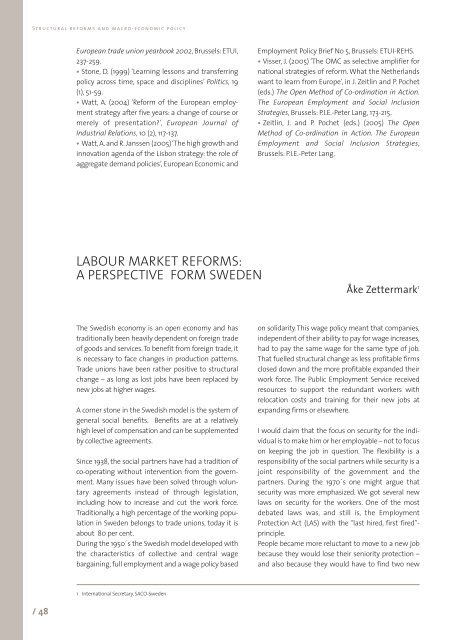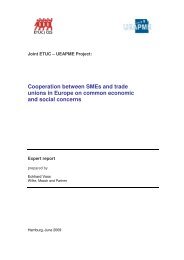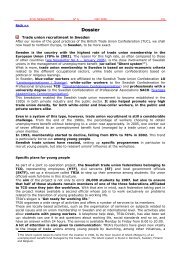Structural reforms and macro-economic policy - ETUC
Structural reforms and macro-economic policy - ETUC
Structural reforms and macro-economic policy - ETUC
Create successful ePaper yourself
Turn your PDF publications into a flip-book with our unique Google optimized e-Paper software.
<strong>Structural</strong> <strong>reforms</strong> <strong>and</strong> <strong>macro</strong>-<strong>economic</strong> <strong>policy</strong><br />
/ 48<br />
European trade union yearbook 2002, Brussels: ETUI,<br />
237-259.<br />
• Stone, D. (1999) ‘Learning lessons <strong>and</strong> transferring<br />
<strong>policy</strong> across time, space <strong>and</strong> disciplines’ Politics, 19<br />
(1), 51-59.<br />
• Watt, A. (2004) ‘Reform of the European employment<br />
strategy after five years: a change of course or<br />
merely of presentation?’, European Journal of<br />
Industrial Relations, 10 (2), 117-137.<br />
• Watt, A. <strong>and</strong> R. Janssen (2005) ‘The high growth <strong>and</strong><br />
innovation agenda of the Lisbon strategy: the role of<br />
aggregate dem<strong>and</strong> policies’, European Economic <strong>and</strong><br />
LABOUR MARKET REFORMS:<br />
A PERSPECTIVE FORM SWEDEN<br />
The Swedish economy is an open economy <strong>and</strong> has<br />
traditionally been heavily dependent on foreign trade<br />
of goods <strong>and</strong> services. To benefit from foreign trade, it<br />
is necessary to face changes in production patterns.<br />
Trade unions have been rather positive to structural<br />
change – as long as lost jobs have been replaced by<br />
new jobs at higher wages.<br />
A corner stone in the Swedish model is the system of<br />
general social benefits. Benefits are at a relatively<br />
high level of compensation <strong>and</strong> can be supplemented<br />
by collective agreements.<br />
Since 1938, the social partners have had a tradition of<br />
co-operating without intervention from the government.<br />
Many issues have been solved through voluntary<br />
agreements instead of through legislation,<br />
including how to increase <strong>and</strong> cut the work force.<br />
Traditionally, a high percentage of the working population<br />
in Sweden belongs to trade unions, today it is<br />
about 80 per cent.<br />
During the 1950´s the Swedish model developed with<br />
the characteristics of collective <strong>and</strong> central wage<br />
bargaining, full employment <strong>and</strong> a wage <strong>policy</strong> based<br />
1 International Secretary, SACO-Sweden<br />
Employment Policy Brief No 5, Brussels: ETUI-REHS.<br />
• Visser, J. (2005) ‘The OMC as selective amplifier for<br />
national strategies of reform. What the Netherl<strong>and</strong>s<br />
want to learn from Europe’, in J. Zeitlin <strong>and</strong> P. Pochet<br />
(eds.) The Open Method of Co-ordination in Action.<br />
The European Employment <strong>and</strong> Social Inclusion<br />
Strategies, Brussels: P.I.E.-Peter Lang, 173-215.<br />
• Zeitlin, J. <strong>and</strong> P. Pochet (eds.) (2005) The Open<br />
Method of Co-ordination in Action. The European<br />
Employment <strong>and</strong> Social Inclusion Strategies,<br />
Brussels: P.I.E.-Peter Lang.<br />
Åke Zettermark 1<br />
on solidarity. This wage <strong>policy</strong> meant that companies,<br />
independent of their ability to pay for wage increases,<br />
had to pay the same wage for the same type of job.<br />
That fuelled structural change as less profitable firms<br />
closed down <strong>and</strong> the more profitable exp<strong>and</strong>ed their<br />
work force. The Public Employment Service received<br />
resources to support the redundant workers with<br />
relocation costs <strong>and</strong> training for their new jobs at<br />
exp<strong>and</strong>ing firms or elsewhere.<br />
I would claim that the focus on security for the individual<br />
is to make him or her employable – not to focus<br />
on keeping the job in question. The flexibility is a<br />
responsibility of the social partners while security is a<br />
joint responsibility of the government <strong>and</strong> the<br />
partners. During the 1970´s one might argue that<br />
security was more emphasized. We got several new<br />
laws on security for the workers. One of the most<br />
debated laws was, <strong>and</strong> still is, the Employment<br />
Protection Act (LAS) with the “last hired, first fired”principle.<br />
People became more reluctant to move to a new job<br />
because they would lose their seniority protection –<br />
<strong>and</strong> also because they would have to find two new

















